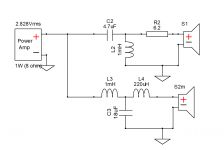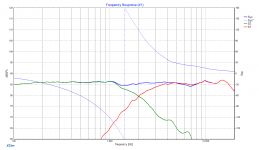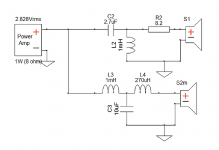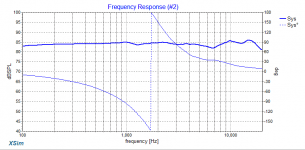Would anyone be able to sim a crossover for a 2 way vented box? I will be using a
Wavecor 8 ohm
https://www.parts-express.com/pedoc...wavecor-wf182bd09-10-11-12-specifications.pdf
and a Morel tweeter
https://www.parts-express.com/pedocs/specs/277-082--morel-cat-308-spec-sheet.pdf
I have done calculations from Allen’s “designing crossover without measurement” and can share if it would be of interest.
Is there any design software out there that will run on Mac?
Thank you to everyone for any help.
Wavecor 8 ohm
https://www.parts-express.com/pedoc...wavecor-wf182bd09-10-11-12-specifications.pdf
and a Morel tweeter
https://www.parts-express.com/pedocs/specs/277-082--morel-cat-308-spec-sheet.pdf
I have done calculations from Allen’s “designing crossover without measurement” and can share if it would be of interest.
Is there any design software out there that will run on Mac?
Thank you to everyone for any help.
Virtually none. Crossover, bootcamp, Parallels or VMware to the rescue!Is there any design software out there that will run on Mac?
Tho I normally use it on Windows, I have run XSim on the Mac under Wine and it's flawless. Kind of a pain to get Wine set up, but it does work. That's where to go if you can.
I can sim a basic Xover if you like.
I can sim a basic Xover if you like.
Pano, thanks and I would take you up on your kind offer. As far as the Mac I guess it would be easier to borrow a friends pc to run it on.
Any ideas for speaker companies that would offer crossover design service?
Madisound has a cross over design service (LINK), but they don't carry Wavecor drivers so I think you're out of luck as they take driver measurements. They may do it if you send them the Wavecors, you'd have to contact them.
I haven't seen any kits with 8 ohm Wavecor you have, the ones I've seen use the 4 ohm version.
So... I see the following options:
1. Use Madisound. Dependent on whether they'll let you send the drivers and if your location makes that too expensive.
2. Find someone here with measurement capability that you can send the drivers to. Cost dependent on location of interested parties.
3. Do a simulation. Least preferable as measurements are more accurate. You have some very nice drivers and they really deserve real measurements. With that being said, maybe a simulation is the only option. We would need the dimensions of the cabinet and the location of the drivers on the cabinet . Have you gotten that far? Here's a link that lists the simulation steps I would perform: LINK. Different tools can be used than those referenced, but you do need the information listed.
Hope this helps...
Last edited:
3. Do a simulation. Least preferable as measurements are more accurate. You have some very nice drivers and they really deserve real measurements. With that being said, maybe a simulation is the only option. We would need the dimensions of the cabinet and the location of the drivers on the cabinet . Have you gotten that far? Here's a link that lists the simulation steps I would perform: LINK. Different tools can be used than those referenced, but you do need the information listed.
I’ll get my hands on a pc and run some of these programs. Cabinet size is 9”w x 18”h x 12”d but that could change.
Hi JT, I'll have a first crack at it today. Do you have a preferred filter slope? 1st, 2nd, 3rd, Butterworth or other? I'll probably just look for what sums best without too many parts.
Also, which impedance woofer are you using? 4 or 8 ohm?
Also, which impedance woofer are you using? 4 or 8 ohm?
Here is what I came up with for the 4 ohm Wavecor woofer. This is all from published specs with the woofer voice coil and estimated 45mm behind the tweeter voice coil. Knowing the actual delay between the two drivers would be a big help.
Although it looks like 2nd order on the tweeter and 3rd order on the woofer, the acoustic slopes are closer to 2nd order woofer and 3rd order tweeter high pass. The two inductor low pass filter is to keep the woofer's strong rising response and cone breakup down about 18-20dB, which should sound clean and also help off axis response.
Although it looks like 2nd order on the tweeter and 3rd order on the woofer, the acoustic slopes are closer to 2nd order woofer and 3rd order tweeter high pass. The two inductor low pass filter is to keep the woofer's strong rising response and cone breakup down about 18-20dB, which should sound clean and also help off axis response.
Attachments
Hi Pano, the drivers I’m using are both 8 ohm. So would that half the capacitors and 2x inductors approximately?
Here is what I came up with for the 8 ohm version of the woofer. The values aren't too different from the first version.
Caveat: This is based on published driver specs and a driver offset of 45mm. Real world will be different. The best thing to do is measure the drivers once they are in the speaker cabinet. But it looks like a simple crossover will work well with these drivers, even tho it will need some tweaking for real world measurements. You might like to build in some baffle step correction.
You can easily run REW on the MacOS and get a measurement mic to do your own graphs. Impedance measurements are a little harder, but they should not be very different in the crossover range from the published charts and those could be used.
Caveat: This is based on published driver specs and a driver offset of 45mm. Real world will be different. The best thing to do is measure the drivers once they are in the speaker cabinet. But it looks like a simple crossover will work well with these drivers, even tho it will need some tweaking for real world measurements. You might like to build in some baffle step correction.
You can easily run REW on the MacOS and get a measurement mic to do your own graphs. Impedance measurements are a little harder, but they should not be very different in the crossover range from the published charts and those could be used.
Attachments
- Home
- Loudspeakers
- Multi-Way
- Crossover design



